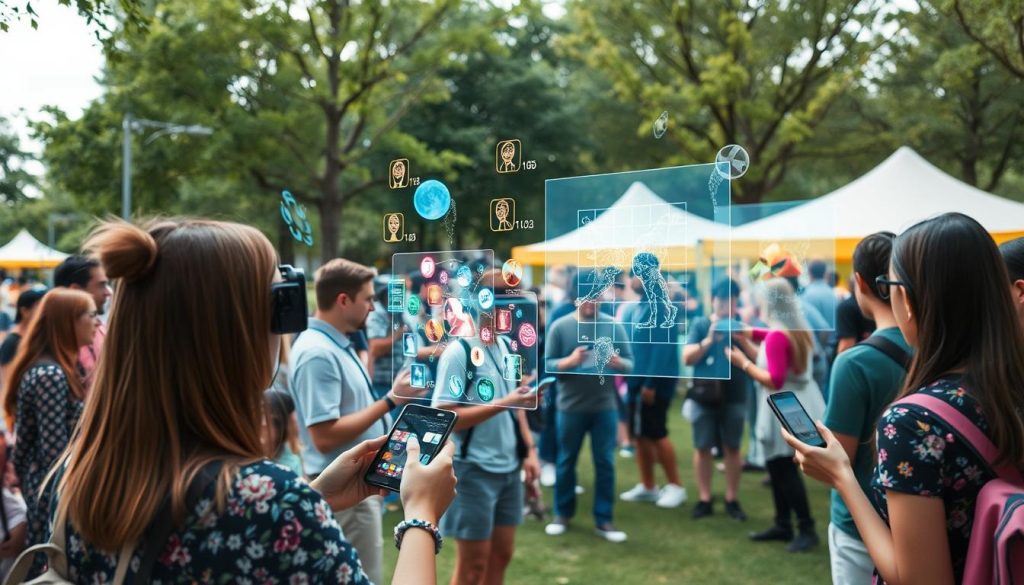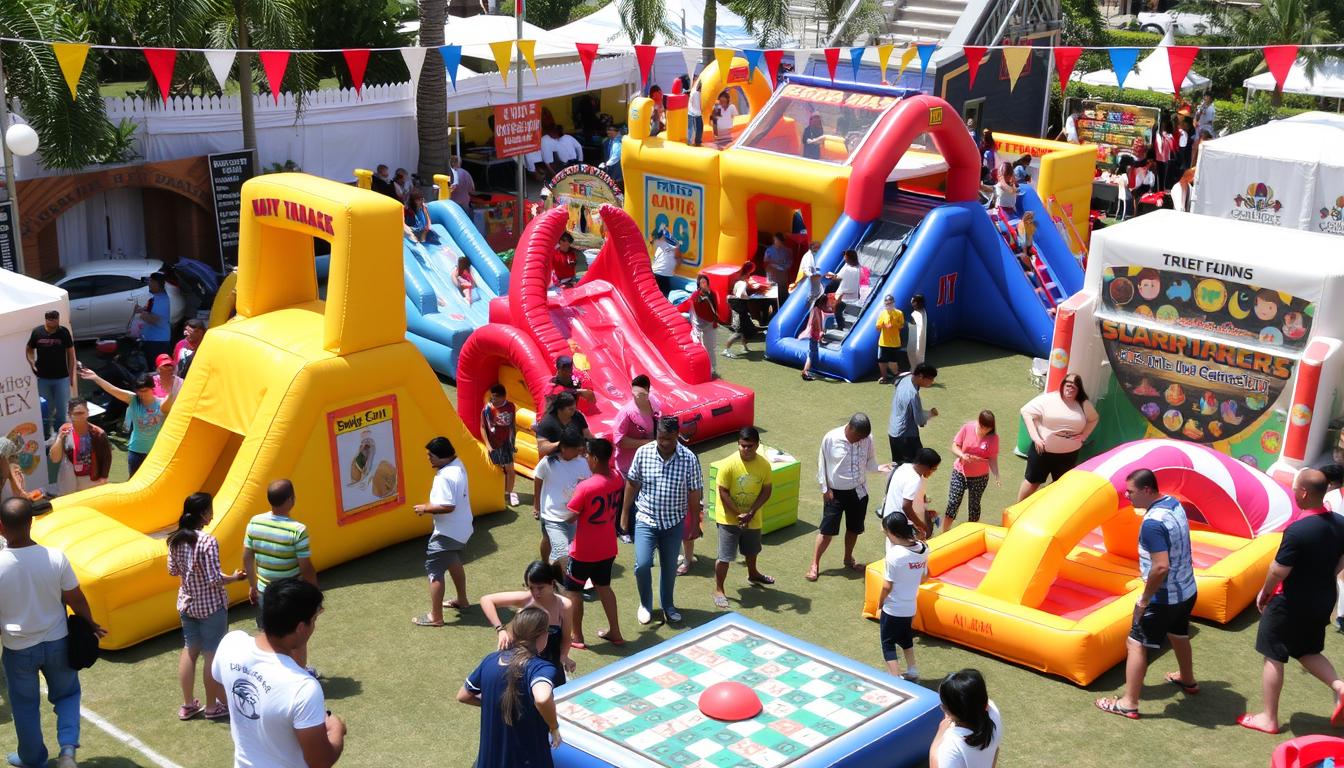Looking to spice up your next event? Interactive event games are the secret sauce that can turn a ho-hum gathering into an unforgettable experience. These engaging activities are revolutionizing the way we approach event planning, offering a fresh take on experiential marketing that captivates attendees and leaves lasting impressions.
Gone are the days of passive participation. Today’s event-goers crave interaction, and gamification is the answer. By incorporating interactive elements, you’re not just entertaining your guests; you’re creating an immersive environment that fosters engagement, boosts brand recall, and generates buzz long after the event wraps up.
Whether you’re organizing a corporate seminar, a trade show, or a social gathering, interactive event games offer a versatile solution to elevate your event’s success. They break the ice, spark conversations, and create shared experiences that resonate with participants on a deeper level.
Key Takeaways
- Interactive event games boost engagement and create memorable experiences
- Gamification enhances brand recall and participant interaction
- These activities suit various event types, from corporate to social gatherings
- Interactive games foster networking and break the ice among attendees
- Experiential marketing through games leaves a lasting impact on participants
Understanding the Power of Interactive Event Games
Interactive event games have revolutionized the way we approach event entertainment. These dynamic experiences captivate attendees, creating memorable moments that leave lasting impressions. Let’s explore the magic behind these engaging activities and their impact on event success.
Defining Interactive Event Entertainment
Interactive event entertainment refers to participatory activities that blend technology, creativity, and audience engagement. These immersive experiences go beyond passive observation, encouraging active involvement from attendees. From digital scavenger hunts to virtual reality challenges, these games transform ordinary events into extraordinary adventures.
The Psychology Behind Engagement
The power of interactive games lies in their ability to tap into fundamental human desires. They create a sense of achievement, foster social connections, and stimulate curiosity. By appealing to these psychological drivers, event organizers can significantly boost audience engagement and create more enjoyable experiences.
Impact on Event Success Metrics
Interactive games directly influence key event success metrics. They increase attendee satisfaction, extend dwell time, and enhance brand recall. By providing unique and shareable moments, these activities also amplify social media buzz and word-of-mouth marketing. The data gathered from these interactions offers valuable insights for future event planning and audience understanding.
“Interactive games are not just entertainment; they’re powerful tools for creating unforgettable event experiences and driving measurable results.”
By harnessing the power of interactive event games, organizers can create truly immersive experiences that resonate with attendees long after the event concludes.
Interactive Games: The Best Way to Stand Out at Your Next Event
Brand activation through interactive games has become the best way to stand out at your next event. These engaging experiences create lasting impressions and drive meaningful connections with participants.
Creating Memorable Brand Experiences
Interactive games offer unique opportunities for brand activation. By immersing attendees in fun, challenging activities, companies can showcase their values and personality. This approach goes beyond traditional marketing, leaving a lasting impact on participants.
Driving Participant Engagement
Engagement is key to event success. Interactive games captivate audiences, encouraging active participation and fostering connections. Whether it’s a virtual reality experience or a team-based challenge, these activities keep attendees involved and excited throughout the event.
Measuring ROI Through Interactive Entertainment
To truly stand out at your next event, it’s crucial to measure the impact of interactive games. By tracking metrics like participation rates, social media mentions, and lead generation, organizers can quantify the return on investment. Interactive entertainment not only engages attendees but also provides valuable data for future event planning.
“Interactive games transform passive observers into active participants, creating unforgettable brand experiences.”
By leveraging interactive games, event planners can create dynamic, memorable experiences that resonate with attendees long after the event concludes. This approach ensures that your brand stands out in a crowded market, making a lasting impression on your target audience.
Top Technology-Driven Interactive Game Solutions
Interactive technology has revolutionized event entertainment, offering unique ways to boost audience engagement. From augmented reality experiences to mobile-based games, these cutting-edge solutions transform ordinary gatherings into unforgettable adventures.
Virtual reality (VR) headsets transport attendees to immersive worlds, perfect for product demonstrations or team-building exercises. Gesture-controlled games use motion sensors to create physical, energetic activities that get everyone moving and interacting.
Touch-screen kiosks provide interactive quizzes and surveys, collecting valuable data while entertaining participants. These games can be customized to fit any event theme or brand message, enhancing audience engagement and leaving lasting impressions.
Social media walls display real-time posts and photos from attendees, fostering a sense of community and encouraging online interaction. Gamified apps turn smartphones into powerful tools for scavenger hunts, trivia contests, and networking challenges.
“Interactive games transform passive observers into active participants, creating memorable experiences that resonate long after the event ends.”
As technology evolves, so do the possibilities for interactive event games. From AI-powered chatbots to holographic displays, the future of audience engagement is bright, innovative, and endlessly exciting.
Designing Custom Interactive Experiences for Different Event Types
Crafting unique interactive experiences tailored to specific events is key to engaging attendees. From corporate team building activities to trade show excitement, each event type demands a custom approach to experiential marketing that resonates with the audience and achieves event goals.
Corporate Events and Team Building
Corporate events thrive on interactive games that foster collaboration. Team building activities like escape rooms or problem-solving challenges boost morale and improve communication. These games create shared experiences that strengthen workplace bonds and enhance productivity.

Trade Shows and Exhibitions
At trade shows, interactive experiences draw visitors to your booth. Virtual reality product demos or touchscreen quizzes about your industry can captivate potential clients. These engaging activities not only attract attention but also provide valuable lead generation opportunities.
Social Gatherings and Celebrations
For social events, fun is the focus. Photo booths with custom props, digital scavenger hunts, or interactive dance floors create memorable moments. These experiences encourage mingling and sharing, amplifying the event’s enjoyment factor.
| Event Type | Interactive Experience | Benefit |
|---|---|---|
| Corporate | Escape Room | Team Bonding |
| Trade Show | VR Product Demo | Lead Generation |
| Social | Digital Scavenger Hunt | Guest Engagement |
By tailoring interactive experiences to each event type, organizers can create lasting impressions and achieve their specific goals. Whether building team spirit, generating leads, or creating joyful memories, custom-designed games and activities elevate any event.
Gamification Strategies for Maximum Engagement
Gamification has revolutionized the way events captivate audiences. By incorporating game-like elements, organizers can boost audience engagement and create unforgettable experiences. Let’s explore some effective strategies to maximize participation at your next event.
Point systems are a cornerstone of gamification. Attendees earn points for various activities, from visiting booths to participating in discussions. This simple yet powerful mechanic drives behavior and encourages active involvement throughout the event.
Leaderboards take engagement to the next level. By displaying top performers, you spark friendly competition and motivate participants to climb the ranks. This strategy can be particularly effective in retaining audience, much like how beauty businesses use loyalty programs to keep customers coming back.
Challenges and quests add an extra layer of excitement. Design tasks that align with your event goals, such as networking challenges or product discovery quests. These not only entertain but also guide attendees towards key areas of your event.
Rewards are the icing on the gamification cake. Offer both virtual and tangible prizes to keep participants motivated. This could range from digital badges to exclusive access or real-world merchandise.
| Gamification Element | Benefits | Implementation Tips |
|---|---|---|
| Point Systems | Drives participation, Quantifies engagement | Balance point values, Offer multiple earning opportunities |
| Leaderboards | Sparks competition, Increases visibility | Update in real-time, Highlight different achievements |
| Challenges | Guides exploration, Enhances interactivity | Align with event goals, Vary difficulty levels |
| Rewards | Motivates continued engagement, Provides tangible benefits | Mix virtual and physical rewards, Ensure relevance to audience |
By implementing these gamification strategies, you’ll create an immersive environment that keeps your audience engaged and excited throughout your event. Remember to tailor these elements to your specific audience and event objectives for maximum impact.
Integration of Digital and Physical Interactive Elements
Event games are evolving, blending digital and physical elements to create immersive experiences. This fusion of interactive technology transforms ordinary gatherings into unforgettable events. Let’s explore how these innovations are reshaping the event landscape.
Augmented Reality Games
AR games add a digital layer to the real world, enhancing engagement. Attendees use their smartphones to unlock hidden content, solve puzzles, or participate in virtual scavenger hunts. These games turn passive observers into active participants, making events more exciting and memorable.

Mobile-Based Interactive Solutions
Smartphones are powerful tools for event interaction. Custom apps allow guests to vote, answer polls, or compete in real-time quizzes. These mobile-based solutions keep attendees engaged throughout the event, fostering a sense of community and shared experience.
Physical Activity Integration
Combining digital elements with physical activities creates truly immersive experiences. Dance-offs guided by digital prompts, tech-enhanced obstacle courses, or motion-sensing games blend the virtual and real worlds seamlessly. This integration appeals to various senses, making events more inclusive and enjoyable for all attendees.
| Interactive Element | Digital Component | Physical Component | Engagement Level |
|---|---|---|---|
| AR Scavenger Hunt | Virtual clues and objects | Physical exploration of venue | High |
| Interactive Quiz Game | Mobile app with questions | Team discussions | Medium |
| Tech-Enhanced Dance-Off | Digital dance prompts | Physical dancing | Very High |
Best Practices for Interactive Game Implementation
Implementing interactive games at events requires careful planning and execution. To make your event entertainment shine, consider these key practices for successful brand activation through games.
Start by defining clear objectives for your interactive games. Are you aiming to boost engagement, collect leads, or educate attendees? Align your game design with these goals to ensure meaningful interactions.
Choose games that resonate with your target audience. Consider age, interests, and tech-savviness when selecting or creating interactive experiences. This tailored approach enhances participation and enjoyment.
“The right game can transform an ordinary event into an unforgettable experience, driving both engagement and brand recall.”
Test your games thoroughly before the event. This helps identify potential issues and allows time for refinements. On event day, have tech support readily available to address any unexpected glitches.
Train your staff to facilitate the games effectively. They should be able to explain rules, encourage participation, and troubleshoot minor issues. This ensures a smooth experience for all attendees.
Incorporate data collection methods into your games to gather valuable insights. Use this information to improve future events and measure ROI.
| Game Type | Best For | Engagement Level |
|---|---|---|
| AR Scavenger Hunts | Trade Shows | High |
| Digital Trivia | Corporate Events | Medium |
| VR Experiences | Product Launches | Very High |
By following these best practices, you’ll create engaging event entertainment that leaves a lasting impression on attendees and achieves your brand activation goals.
Measuring Success and Gathering Participant Feedback
To truly understand the impact of interactive event games, it’s crucial to measure their success. This process helps event organizers refine their strategies and create even more engaging experiences in the future. Let’s dive into how we can gauge the effectiveness of these games and use that information to improve.
Key Performance Indicators
When evaluating interactive games, several metrics can indicate success. These include participation rates, time spent engaging with the game, and social media mentions. By tracking these KPIs, organizers can determine if their games are truly maximizing audience engagement and standing out at events.
Data Collection Methods
Gathering feedback is essential for improvement. Post-event surveys, in-game analytics, and on-site observations are effective ways to collect data. These methods provide insights into what worked well and what needs tweaking, helping organizers refine their approach for future events.
Analysis and Improvement Strategies
Once data is collected, it’s time to analyze and act on it. This might involve adjusting game mechanics, updating technology, or rethinking the overall concept. The goal is to continually enhance the interactive experience, ensuring it remains the best way to stand out at your next event and keeps participants coming back for more.
FAQ
What are interactive event games?
Interactive event games are engaging activities designed to enhance attendee participation and create memorable experiences at various types of events. These games utilize gamification techniques and often incorporate interactive technology to boost audience engagement and achieve specific event objectives.
How do interactive event games improve audience engagement?
Interactive event games improve audience engagement by creating immersive experiences that captivate attendees’ attention. They encourage active participation, foster social interaction, and provide a fun, competitive element that keeps participants invested in the event activities.
Can interactive games be customized for different types of events?
Absolutely! Interactive games can be tailored to suit various event types, including corporate events, trade shows, and social gatherings. Custom solutions can be designed to align with specific event objectives, whether it’s team building activities for a corporate retreat or brand activation at a product launch.
What technology is commonly used in interactive event games?
Common technologies used in interactive event games include mobile apps, augmented reality (AR), touchscreen displays, RFID wristbands, and motion sensors. These interactive technologies enable a wide range of engaging experiences, from digital scavenger hunts to virtual reality simulations.
How can I measure the success of interactive games at my event?
Success can be measured through various metrics, including participation rates, dwell time at game stations, social media mentions, and post-event surveys. Analyzing these key performance indicators helps gauge the effectiveness of your experiential marketing efforts and identify areas for improvement.
Are interactive event games suitable for all age groups?
Yes, interactive event games can be designed to appeal to all age groups. The key is to tailor the game mechanics, difficulty level, and themes to suit your target audience. Whether it’s a family-friendly carnival game or a sophisticated corporate challenge, there’s an interactive solution for every demographic.
How do interactive games contribute to brand activation?
Interactive games are excellent tools for brand activation as they create memorable, hands-on experiences with your brand. They can showcase products, communicate brand values, and foster emotional connections with participants, leading to increased brand recall and positive associations.
What’s the best way to integrate interactive games into my event?
The best way to stand out at your next event is to seamlessly integrate interactive games into your overall event strategy. This involves careful planning, aligning game objectives with event goals, ensuring proper technical setup, and training staff to facilitate the games effectively.
Can interactive games be used for team building?
Absolutely! Interactive games are excellent for team building activities. They promote collaboration, communication, and problem-solving skills in a fun, engaging environment. Many games can be designed specifically to enhance teamwork and foster stronger connections among participants.
How do I choose the right interactive game for my event?
Selecting the right interactive game depends on factors such as your event objectives, audience demographics, venue constraints, and budget. Consider working with experienced event entertainment professionals who can help you design or select games that best fit your specific needs and goals.


